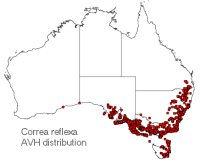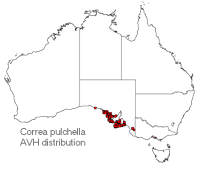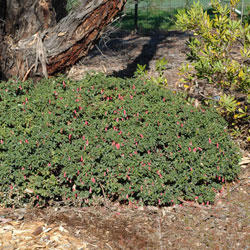Correa 'Dusky Bells'
Correa 'Dusky Bells' nom. cult. APNI
Correa 'Dusky Bells' ACRA Registration
Correa ‘ Dusky Bells ’ belongs to the Rutaceae family which includes the commercial citrus fruits. The Australian endemic genus Correa is a small group within this family.
The genus Correa is named after the Portuguese botanist Correia de Serra. Correa ‘ Dusky Bells ’ is a probable hybrid of C. reflexa and C. pulchella. It is thought that it may have been cultivated for at least 50 years. In 1986, its registration with Australian Cultivar Registration Authority (ACRA) was applied for by W. R. and G. M. Elliott, though the cultivar was received by the authority in 1980. Its synonyms are: Correa ‘Pink Bells’, Correa ‘Carmine Bells’, Correa ‘Rubra’ and Correa sp. (Pink).
 |
 |
Correa reflexa, a parent species of Correa ‘Dusky Bells’, ranges from southern Queensland, New South Wales, Victoria, eastern South Australia and Tasmania. Correa pulchella is pretty much restricted to South Australia. Both of the parent species are mostly distributed in temperate regions. Therefore, it can be inferred that Correa ‘Dusky Bells’ is not likely to grow well in the hot tropics such as northern Queensland.
It is an attractive evergreen shrub which grows to 1m high and to 2-4 m in diameter. The entire plant is stellate hairy. Leaves have stellate hairs and the older leaves lose hairs. The leaves are to 4.5 cm long, and 2.5 cm wide; narrow oval (elliptic) or lance-shaped (lanceolate) to egg-shaped leaf (ovate). The beautiful bell-shaped flowers are up to 2.5cm long. The four fused petals are pale carmine pink.
Hybrid Correas have a tendency to be more compact and heavy flowering than the wild species, which makes them a desirable gardening plant. Correa ‘Dusky Bells’ is drought and frost tolerant. It is great for a shaded environment. It prefers somewhat shady situations rather than full sun. It also attracts birds to the gardens. Many of the Correa species are pollinated by birds such as honey eaters as it normally has a lot of nectar.
Flowering time is from March to September. However, it also flowers sporadically displaying its lovely bell-shaped flowers throughout a year.
In general, growing Correa ’Dusky Bells’ is easy. It prefers moist soil, though it is drought tolerant. It grows wells on friable, well-drained and fertile loam. Propagation of this plant is possible by cutting. If it grows tall or wide, you can prune the plant. Regular pruning is good for the plant. As you could see from the distribution map it is not likely to grow well in the tropics. It is best to avoid humid areas. Scale infestation of Correa due to insidious black smut was reported, but it is not common.
Correa ‘Dusky Bells’ is an excellent evergreen garden plant. It is easy-to-grow, drought and frost tolerant and beautiful.
Text by BoKyung Choi (2007 Botanical Intern)
Name Meaning: Correa 'Dusky Bells'Correa – after Correia de Serra, a Portuguese botanist and diplomat (1751 – 1823) 'Dusky Bells' – was a name used in the nursery industry for this cultivar for many years, and adoped when it was formally registered with ACRA. |
References
McCarthy, N. 2001. Correas-Wild Fuchsia, Native Plants for New South Wales 36 (1): 19
Payne, B. 1999. Pacific Horticulture 60(3): 20
Elliot, W. 1984. Encyclopedia of Australian Plants Vol. 3: 96-97, Lothian Publishing Company, Melbourne
ACRA: Australian Cultivar Registration Authority. Available at http://www.anbg.gov.au/acra [accessed February 5th, 2007]
![An Australian Government Initiative [logo]](/images/austgovt_brown_90px.gif)



